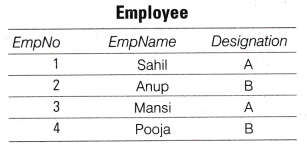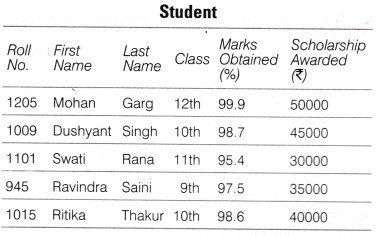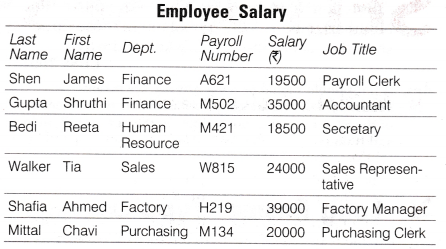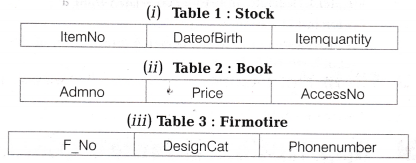NCERT Solutions for Class 10 Foundation of Information Technology – Database Concepts
Very Short Answer Type Questions [1 Mark each]
Question 1.
What is database? Give example. CBSE 2010
Answer:
A collection of related information organised as tables is known as database, e.g. INGRES, MySQL etc.
Question 2.
Write the purpose of DBMS. CBSE 2007
Answer:
DBMS is used to store logically related information at a centralised location. It facilitates data sharing among all the applications requiring it.
More Resources for CBSE Class 10
- NCERT Solutions
- NCERT Solutions for Class 10 Science
- NCERT Solutions for Class 10 Maths
- NCERT Solutions for Class 10 Social
- NCERT Solutions for Class 10 English
- NCERT Solutions for Class 10 Hindi
- NCERT Solutions for Class 10 Sanskrit
- NCERT Solutions for Class 10 Foundation of IT
- RD Sharma Class 10 Solutions
Question 3.
Write the relationship between a database and a table. CBSE 2008
Answer:
A database contains multiple tables whereas, a table cannot exist outside a database.
Question 4.
Give any one use of database. CBSE 2003
Answer:
A database is used to store logically related information in table.
Question 5.
What is field in database? Give an example.
Answer:
A field is an area, reserved for a specific piece of data. It is also known as attribute, e.g. Customer_Name.
Question 6.
Define the term DBMS. CBSE 2010
Answer:
The full form of DBMS is Database Management System. It is a computer based record keeping system.
Question 7.
State the primary goal of a DBMS.
Answer:
To provide a convenient and efficient environment in which we can store and retrieve information.
Question 8.
Write any two uses of database management system. CBSE 2007
Answer:
- DBMS is used to store data at a centralised location.
- It is used to minimise data redundancy and data inconsistency.
Question 9.
Give any two disadvantages of the database.
Answer:
- High complexity
- Database failure
Question 10.
Write any two advantages of using database.
Answer:
- Can ensure data security.
- Reduces the data redundancy.
Question 11.
What is a primary key? CBSE 2003
Or
Define primary key with an example. CBSE 2005
Or
What is primary key? Give an example. CBSE 2007
Or
What is a primary key in database? Give an example. CBSE 2010
Answer:
A field which uniquely identifies each record in a table is known as primary key. e.g. empld is the primary key of the Employee table.
Question 12.
Give one advantage of using primary key.
Answer:
A primary key uniquely identifies the record in the table.
Question 13.
What is the significance of a primary key?
Answer:
A primary key cannot allow null values and must have a unique index.
Question 14.
Name two possible primary keys for an Employee table. CBSE 2007
Answer:
Possible primary keys for an Employee table are empcode, empphonenumber.
Question 15.
Write the significance of a foreign key.
Answer:
A foreign key is used to Establish relationship between any two tables of RDBMS.
Question 16.
What is the default extension of OO.o not zero BASE database? CBSE 2005
Answer:
The default extension of OO.o BASE database is .odb.
Short Answer Type Questions [2 & 3 Marks each]
Question 1.
What are the main purposes of a database system?
Answer:
- Storage of information.
- Retrieval of information quickly.
- Sorting, selecting data that satisfies certain criteria (filtering).
- Produce the report in some standardised and readable format.
Question 2.
How are fields, record and a table related to each other? Explain with the help of an example. CBSE 2007
Answer:
Fields are one type of information. A record contains logically related fields. A table Emp name contains logically related records.
| EmpNo | Name | Salary |
| 1. | Shridhar | 20000 |
| 2. | Raghav | 40000 |
Here EmpNo, Name and Salary are three different fields. 1, Shridhar, 20000 represents one complete record.
Question 3.
What is the difference between ‘Rows’ and ‘Columns’ in a table? CBSE 2002
Answer:
In a table, rows are called records and columns are termed as fields. A row stores complete information of a record whereas column stores only similar data values for all records.
Question 4.
Distinguish between data and information. CBSE 2007
Answer:
Distinguish between data and information are as follows:
| Data | Information |
| It is a raw facts. | It is a process form of data. |
| It considers facts symbols, images for reference or analysis. | It considers knowledge derived from study, experience or instruction. |
| e.g. 23 is a data. | e.g. age = 23 is information. |
Question 5.
Define query in the context of database.
Answer:
A query is an inquiry into the database using the SELECT statement.These statements give you filtered data according to your conditions and specifications indicating the fields, records and summaries which a user wants to fetch from a database.
Question 6.
Define forms and what is the need of using them? CBSE 2006
Answer:
In a database, a form is a window or a screen that contains numerous fields or spaces to enter data. Forms can be used to view and edit your data. It is an interface in user specified layout.
e.g. a user can create a data entry form that looks exactly like a paper form. People generally prefer to enter data into a well-designed form, rather than a table.
Question 7.
What do you understand by report?
Answer:
When you want to print those records which are fetched from your database, design a report. It is an effective way to present data in a printed format. It allows you to represent data retrieved from one or more tables, so that it can be analysed.
Question 8.
What do you mean by DBMS? CBSE 2004
Answer:
It is a collection of programs that enables users to create, maintain database and control all the access to the database. It is a computer based record keeping system. DBMS is a software package that manages database, e.g. MySQL, INGRES, MS-ACCESS etc.
DBMS is actually a tool that is used to perform any kind of operation on data in database.
Question 9.
Define RDBMS.
Answer:
RDBMS is a type of DataBase Management System that stores data in the form of relations (tables). Relational databases are powerful, so they require few assumptions about how data is related or how, it will be extracted from the database.
Question 10.
A table named School (containing data of students of the whole school) is created, where each record consists of several fields including AdmissionNo (Admission Number), RollNo (Roll Number), Name. Which field out of these three should be set as the primary key and why? CBSE 2007
Answer:
AdmissionNo should be set as primary key because admission numbers are unique for each and every students of the school, which is not possible in the case with RollNo and Name.
Question 11.
What is the utility of primary key in database? Write distinct features of primary keys. CBSE 2013
Answer:
Primary key is used to uniquely identify the record in a database. It can be a column or a set of columns in the table. Main features of primary key are as follows:
- It must contain a unique value for each record of table.
- It does not contain null values.
Long Answer Type Questions [5 Marks each]
Question 1.
Discuss the components of a database.
Answer:
A database consists of several components. Each component plays an important role in the database system environment.
The major components of database are as follows:
-
Data
It is raw numbers, characters or facts represented by value. Most of the organisations generate, store and process large amount of data. The data acts as a bridge between the hardware and the software. Data may be of different types such as User data, Metadata and Application Metadata. -
Software
It is a set of programs that lies between the stored data and the users of database. It is used to control and manage the overall computerised database. It uses different types of software such as MySQL, Oracle etc. -
Hardware
It is the physical aspect of computer, telecommunication and database, which consists of the secondary storage devices such as magnetic disks, optical discs etc., on which data is stored. -
Users
It is the person, who needs information from the database to carry out its primary business responsibilities.
The various types of users which can access the database system are as follows:
-
Database Administrator (DBA)
A person, who is responsible for managing or establishing policies for the maintenance and handling the overall database management system is called DBA. -
Application Programmers
The people, who write application programs in programming languages to interact and manipulate the database are called application programmers. -
End-user
A person, who interacts with the database system to perform different operations on the database like inserting, deleting etc., through menus or forms.
Question 2.
Define database management system. Write two advantages of using database management system for school. CBSE 2007,05, 04
Answer:
DataBase Management System (DBMS) is a collection of programs that enable users to create, maintain database and control all the access to the database. The primary goal of the DBMS is to provide an environment that is both convenient and efficient for user to retrieve and store information.
The advantages of using DBMS for school are as follows:
- In school, DBMS is used to store the data about students, teachers and any other related thing at a centralised location.
- It provides security to the personal information of the school, stored in it.
Question 3.
Distinguish between a record and a field in a table, with an example. CBSE 2007,05
Answer:
Distinguish between a record and a field in a table are as follows:
| Record | Field |
| It is a collection of data items, which represent a complete unit of information about a thing or a person. | It is an area within the record reserved for a specific piece of data. |
| A record refers to a row in the table. | A field refers to a column in the table. |
| Record is also known as tuple. | Field is also known as attribute. |
| e.g. if Employee is a table, then entire information of an employee is called a record. | e.g. if Empolyee is a table, then empld, empName, department, salary are the fields. |
Question 4.
Write the steps to design a database.
Answer:
Steps to Design a Database
There are various steps to design a database which are as follows:
- Step 1 Determine the purpose of your database The first step of designing a database is to determine the purpose and mechanism to design and use it.
-
Step 2
Determine the tables
Tables are one of the most important elements of a database, consist of rows and columns. To create a well-defined database, you have to keep some conditions which are as follows:
- A table should not contain duplicate information.
-
Each table should contain information about one subject.
e.g. One table is used to contain the personal information of the students and the other is used to contain the marks scored by the student.
-
Step 3 Determine the fields
After creating a table, you need to decide the type and number of fields required for the tables in your database. Each field in a table contains individual facts about the table’s subject.
e.g. A customer table may include company name, address, city, state and phone number fields. - Step 4 Identify the primary key in a table From the fields of table, you need to identify a primary key which uniquely identifies each individual record of the table. The primary key helps you to reduce data duplication in the table.
- Step 5 Determine the relationship between tables In this step, you need to determine relationship between two or more tables in your database. You can set-up a relationship between tables on the basis of common field between them. Establishing a relationship allows you to fetch any information from both the tables.
- Step 6 Refine the design After you have designed the tables, fields and relationships, its time to study the design and detect any faults that might remain.
- Step 7 Enter data and create other database objects When you are satisfied that the database structure meets the goals you needed, add all your existing data to the tables.
Application Oriented Questions
Question 1.
Consider the following table

- Which of the above field can be selected as a primary key?
- EmpName field also has unique values for all the records. Can it be made primary key? Give answer with reason.
Answer:
- EmpNo can be selected as a primary key.
-
EmpName is having unique values, but there is no guarantee that if more employees are included then there would not be multiple people with similar names.
So, in future its values may be duplicate. Thus, it cannot be made as a primary key.
Question 2.
Sanchita is working for a nationalised bank and is in the process of creating a table to store the details of customers of the bank.
Find out, which of the following fields of table Bank can be selected as primary key, candidate key and alternate key? CBSE 2011
Account No, Customer Name, Date of Birth, PAN Number, Opening Balance
Answer:
Primary key
AccountNo
Candidate key
AccountNo and PAN Number
Alternate key
PAN Number
Question 3.
Consider the following database Student

- The marks obtained by the student with RollNo. 1101 is?
- What is the name of the student, who has got the highest marks and what is the amount of scholarship awarded to him/her?
- How many records are there in the table?
- How many fields are there in the table?
Answer:
- 95.4
- Mohan Garg and scholarship awarded is 50000.
- 5
- 6
Question 4.
The director of a company uses a database to store data about job title. This is a part of the database given below

- How many records are there in this part of the database?
- How many fields are there in this part of the database?
- What is the job title of the employee with Payroll Number M421?
- Which department has maximum employees and what are their Payroll Numbers?
Answer:
- 6
- 6
- Secretary
- Finance department and their Payroll Numbers are A621 and M502.
Question 5.
Identify the columns out of the given three, which should not be present in each of the following tables:

Answer:
(i) DateofBirth (ii) Admno (iii) Phonenumber
Multiple Choice Questions [1 Mark each]
Q1. Facilities offered by databases are
(a) The ability to store a large amount of data in a structured format, easy update, sort query, production of reports.
(b) Easy editing, spell check, perform calculations, library of mathematical functions, replication.
(c) The ability to rotate images, copy and paste, fill scale.
(d) None of the above
Answer:
(a)
Databases have ability to store a large amount of data in structured format, easy update, sort query, production of reports.
Q2. Which of the following is not an example of database? CBSE2011
(a) Cross knot game
(b) Employee payroll management
(c) Numeric calculator
(d) Customer management system
Answer:
(c)
Numeric calculator because it is used to calculate the numeric numbers only as it is unable to store data.
Q3. Database is a combination of CBSE 2011
(a) hardware and software
(b) hardware and operating system
(c) software and operating system
(d) utility programs
Answer:
(a)
A database consists of several components. These are data, software, hardware and user.
Q4. Operations performed on a database are controlled by
(a) user
(b) hardware
(c) DBMS
(d) RDBMS
Answer:
(a)
Users are those persons, who need the information from the database to perform operations.
Q5. Database is made up of all the following components except
(a) tables
(b) queries
(c) forms
(d) formula bar
Answer:
(d)
Database is made up of tables, queries and forms.
Q6. Data is stored in RDBMS in the form of
(a) table
(b) query
(c) report
(d) record
Answer:
(a)
Relational Database Management System stores data in the form of relation. As we know, relations are known as table.
Q7. Out of the following, which one is the most appropriate data field in context of employee table, if only one of these is required? CBSE 2011
(a) Age in years
(b) Date of birth
(c) Age in days
(d) Age in months
Answer:
(b)
Date of birth is the most appropriate data field in context of employee table.
Q8. All the information about a thing or a person is known as a
(a) database
(b) file
(c) field
(d) record
Answer:
(d)
A record refers to a raw of data, which represents a complete set of information in a table.
Q9. Which of the following is not the main building block of a database?
(a) Lists
(b) Queries
(c) Reports
(d) Forms
Answer:
(a)
The main building blocks of database are tables, queries, forms and reports.
Q10. Which of the following best describes a form? CBSE 2013
(a) Form enables people to enter or view data in a database easily
(b) Form summarises and prints data
(c) A form filters data from a database based on a criteria
(d) All of the above
Answer:
(a)
Form enables people to enter or view data in a database easily.
Q11. DBMS is a program that controls the creation, maintenance and use of database. Here, DBMS referred to
(a) Digital Base Management System
(b) Data Build Management System
(c) DataBase Management System
(d) DataBase Management Service
Answer:
(c)
Here, DBMS stands for Database Management System.
Q12. Computer based record keeping system is known as
(a) Data Manipulation System
(b) Computerised Data System
(c) Computerised Record keeping system
(d) DBMS
Answer:
(d)
DBMS is a collection of programs that enable user to create and maintain database. Also, it is a computer based record keeping system.
Q13. RDBMS provides relational operators to manipulate the data. Here, RDBMS refers to
(a) Record Database Management System
(b) Relational Database Management System
(c) Reference Database Management System
(d) None of the above
Answer:
(b)
RDBMS stands for Relational Database Management System, which provides operator to manipulate the data stored into the database table.
Q14. A database that contains tables linked by common fields is called a
(a) Centralised database
(b) Flat file database
(c) Relational database
(d) None of these
Answer:
(c)
Relational database stores data in the form of tables which are linked by common fields.
Q15. Duplication of data is known as CBSE 2013
(a) data security
(b) data incomplete
(c) data redundancy
(d) None of these
Answer:
(c)
Data redundancy means duplication of data. It eliminates replication of data item into different files from a large database.
Q16. Which of the following fields will not make a suitable primary key? CBSE 2011
(a) A customer’s account number
(b) A date field
(c) An auto number field
(d) A student’s admission number
Answer:
(b)
From the given options, data field can not be set as a primary key because it can’t be fixed for an object.
Q17. Key field is a unique identifier for each record. It is defined in the form of
(a) rows
(b) columns
(c) tree
(d) query
Answer:
(b)
Key is a data item that allows you to uniquely identify individual occurrences which is defined as the column or set of columns.
Fill in the Blanks [1 Mark each]
Q1.
………….. is a collection of related information.
CBSE 2011
Answer:
Database
Q2.
In database, all the data are stored at a ……………. location.
Answer:
centralised
Q3.
Table is also known as ………… .
Answer:
relation
Q4.
A field in a table is also called as ………………… .
Answer:
column
Q5.
………….. is the smallest part of a table in which one data item can be kept.
CBSE 2011
Answer:
Field
Q6.
A set of related data item is called as ……………. .
Answer:
record
Q7.
The database is managed by a software package known as …………….. .
Answer:
DBMS
Q8.
Primary key is used to …………….. identify the record
Answer:
uniquely
Q9.
A foreign key is a reference of the ………….. key in another table.
Answer:
primary
Q10.
The candidate key, which is not used as primary key is called ………….. key.
Answer:
alternate
True or False [1 Mark each]
Q1. Database is the collection of logically non-related data.
Answer:
False
A database is the collection of integrated and logically related data.
Q2. A relationship cannot be created with the help of a table.
Answer:
False
A relationship is a connection between two tables of data.
Q3. Field contains set of characters.
Answer:
True
It is the individual sub-component of one record. It contains set of characters, which have a proper meaning.
Q4. A report allows you to represent data retrieved from one or more tables so that, it can be analysed and printed if required.
Answer:
True
When you want to print those records which are fetched from your database then, reports are more useful for this purpose.
Q5. If a piece of data (field value) is stored in two places in the database, then storage space is wasted and changing the data in one place will not cause data inconsistency. CBSE 2011
Answer:
False
If a piece of data is stored in two places in the database, then storage space is wasted and changing the data in one spot will cause data inconsistency.
Q6. A database can have only one table. CBSE 2011
Answer:
False
No, database does not have a limit on number of tables. It depends on the disk space.
Q7. Primary key field gives us permission to record duplicate entry.
Answer:
False
A primary key is a key which identifies records uniquely in a table so it does not give us permission to record duplicate entry.
Q8. A primary key field does not allow numbers.
Answer:
False
Primary key has to identify a unique value which can be present in a table, in a number form also. It means, primary key field allow number too.
Q9. A primary key value can be NULL.
Answer:
False The primary key of table is used to uniquely identify each and every row in the table. So, its all keys and columns must be defined as NOT NULL.
Q10. A table can have multiple primary keys. CBSE 2013
Answer:
False
If we create multiple primary keys in a table, then primary key will be unable to find the unique key value.
Q11. A foreign key is a primary key in another table.
Answer:
True
When a table’s primary key field is added to a related table in order to create the common field which relates two tables, it is called a foreign key in the related table.